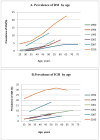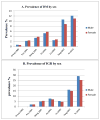THE DIABETES EPIDEMIC IN CHINA: AN INTEGRATED REVIEW OF NATIONAL SURVEYS
- PMID: 27295015
- PMCID: PMC5567749
- DOI: 10.4158/EP161199.RA
THE DIABETES EPIDEMIC IN CHINA: AN INTEGRATED REVIEW OF NATIONAL SURVEYS
Abstract
Objective: To review trends in the prevalence and incidence of diabetes mellitus (DM) and related risk factors in China.
Methods: We searched the literature using PubMed, China Knowledge Resource Integrated Database, and China Wanfang Digital Database for large epidemiologic studies and national surveys.
Results: During the past 30 years (1980-2010), 7 national diabetes mellitus surveys were conducted in China mainland, indicating that the prevalence of DM has increased 17-fold, from 0.67 to 11.6% of the population. The prevalence of impaired glucose regulation (IGR, including impaired fasting glucose and impaired glucose tolerance) also increased, from 2.09 in 1994 to 27.2% in 2010. There was no national representative study of the incidence of diabetes to date; the reported incidence of type 2 diabetes during past 25 years in several cohort studies varied (2.7 to 15.8 per 1,000 person-years). Potential risk factors which could have contributed to the increasing prevalence and incidence of DM and IGR in the Chinese population include social and economic development, urbanization, dietary pattern, and Westernized lifestyle. Further, genetic studies have suggested that unique inheritable risk factors in the Chinese population may increase the risk for DM when compared to Caucasians.
Conclusion: DM and IGR have become epidemic in China. Public health strategies should focus on modifying lifestyle and dietary factors, particularly among those with a susceptible genetic background.
Abbreviations: BMI = body mass index DM = diabetes mellitus FBG = fasting blood glucose GWAS = genome-wide association study IGR = impaired glucose regulation IGT = impaired glucose tolerance OGTT = oral glucose tolerance test T2D = type 2 diabetes WC = waist circumference WHR = waist-hip ratio.
Conflict of interest statement
The authors have no multiplicity of interest to disclose.
Figures




References
-
- International Diabetes Federation. [Accessed March, 2016];IDF Diabetes Atlas. 2013 2014. Available at: http://www.idf.org/diabetesatlas.
-
- Xu Y, Wang L, He J, et al. Prevalence and control of diabetes in Chinese adults. JAMA. 2013;310:948–959. - PubMed
-
- National Diabetes Research Group. Diabetes mellitus survey of 300,000 in fourteen provinces and cities of China. Chin Med J. 1981;20:678–681.
-
- Pan XR, Yang WY, Li GW, Liu J. Prevalence of diabetes and its risk factors in China, 1994. Diabetes Care. 1997;20:1664–1669. - PubMed
-
- Wang K, Li T, Xiang H. Study on the epidemiological characteristics of diabetes mellitus and IGT in China [in Chinese] Chin J Epidemiol. 1998;19:282–285. - PubMed
Publication types
MeSH terms
Grants and funding
LinkOut - more resources
Full Text Sources
Other Literature Sources
Medical
Miscellaneous

